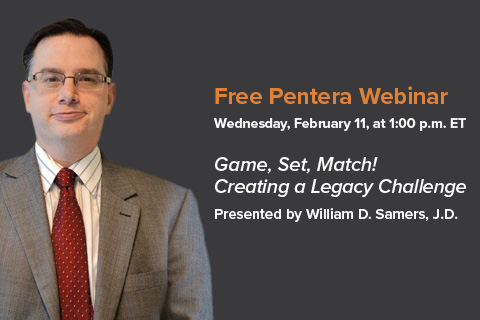
The Pentera Blog
New Insights on Donors and Planned Gifts Revealed in Whitepaper from Pentera
Pentera and the Indiana University Lilly Family School of Philanthropy have released a new research whitepaper on planned giving, "The 2016 Planned Giving Study."
The whitepaper is the first in what is hoped to be a series of reports researched and written by the school and sponsored by Pentera and company President & CEO Claudine A. Donikian, who is a member of the advisory board of the Women's Philanthropy Institute at the school. The study, which is subtitled "New Insights from Data on Planned Gifts," investigates the characteristics of planned gifts and the likelihood of donors making such gifts to nonprofit organizations at various points over the course of a lifetime.
"Planned gifts have historically played a significant role in supporting educational institutions in the U.S.," said Amir Pasic, Ph.D., the Eugene R. Tempel Dean of the school. "The planned giving field is becoming more sophisticated, and this complexity makes it difficult for nonprofits and researchers to track and analyze planned giving behavior. We are pleased to collaborate with Pentera and colleagues from five universities on this important research endeavor that will inform practice and help nonprofits build strong planned giving programs."
Unlike most planned giving research, the study analyzes actual data on planned gifts and donors. The unique data set is from five case-study universities across the country and includes information on planned gifts made from 1972 to 2015 (the date range varies by university).
"Several years ago I realized that there was very little research about the behaviors of actual donors who made actual planned gifts or actual gift intentions, so I approached the Lilly Family School of Philanthropy to initiate and underwrite this national study that is the first to look at institutional data from a sampling of top university planned giving programs. Until now, most research has just been on surveys or tax return data," Ms. Donikian said. "Looking at these top planned giving programs will help us discover best practices that can be used to guide all types of planned giving programs at various organizations."
According to the study, a majority of the top 120 higher education institutions in the U.S. (ranked by endowment value) had established an institution-wide legacy society exclusively for individuals who make planned gifts to the institution. Most of these institutions did not require a minimum gift amount in order to qualify for membership.
Key findings
Analysis of data on planned gifts and donors from the five case-study universities indicates that:
- Nearly three-quarters of planned gift donors were degreed alumni of the university that received their planned gifts.
- Individuals from the Silent and Baby Boomer generations represented more than half of current planned giving donors.
- The likelihood of making a planned gift increased sharply when donors reached approximately 45-50 years of age.
- Donors without children were more likely than those with children to make charitable bequests and had significantly higher average and median dollar amounts of bequests.
- Approximately one-fifth of donors made more than one planned gift to the same university over time. And location matters: Donors living in the same state where the university is located were significantly more likely to make more than one planned gift to the same institution.
- Charitable bequest was the most common planned giving vehicle, but other vehicles represented a significant percentage of gifts.
- The 80/20 rule applies in planned giving, with the majority of planned giving dollars coming from a small group of major donors. In fundraising, the 80/20 rule is the rule of thumb that approximately 80 percent of charitable giving dollars comes from about 20 percent of major donors.
The implications of the findings are explored in the whitepaper, providing insights for gift-planning professionals to help donors achieve both their philanthropic aspirations and their financial goals. Ms. Donikian is presenting study findings, implications, and recommendations in workshops around the country.
"Planned giving is an increasingly important component of philanthropy. The research findings on alumni, distance, and other factors emphasize the importance of relationships with donors," said Una Osili, Ph.D., director of research for the school. "Making one or more planned gifts to an institution is an expression of a donor's strong commitment to that organization. Cultivating those gifts requires nonprofits to build trust with donors and help donors achieve their philanthropic and financial objectives."
To read and download the full whitepaper, visit www.pentera.com/PlannedGivingStudy


